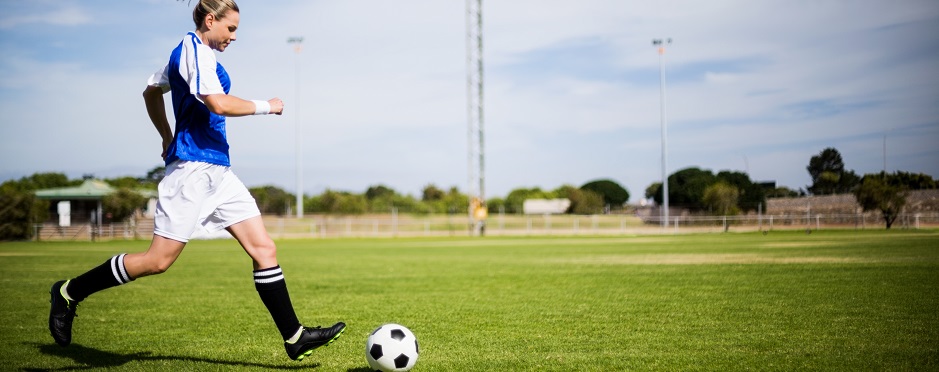
Why Are ACL Tears So Common? 4 Ways to Help Minimize Your Risk of Injury
Leave a CommentAnterior cruciate ligament (ACL) tears, the dreaded injury. Many people know ACL tears are a severe injury, involving a long road of recovery despite surgical or conservative intervention. The ACL is a sturdy ligament deep in the knee joint that stabilizes the knee, specifically with rotational movements. There are two ways to injure your ACL, direct contact or non-contact. A direct contact ACL injury is when the knee takes a direct blow from another person or object. A non-contact ACL injury occurs when pivoting, cutting, twisting, or landing on the knee.
Both types of injuries can be treated with surgical or non-surgical management depending on the individual’s lifestyle, goals, and symptoms. Following an ACL injury, one could expect to hear/feel popping, swelling, bruising, reduced range of motion and strength, and a feeling of less stability in the knee.1
Why Are ACL Injuries On the Rise?
Rates of ACL tears have done nothing but increase as time goes on. As the intensity of youth sports and early specialization is on the rise, so are growing injury rates, specifically ACL tears.2 This is in part due to skeletal immaturity and reduced knee strength.2 ACL injury prevention research has improved over time, yet such protocols have yet to be implemented into the sports community. Hip and core strength, lower extremity movement patterns, and poor balance are other common causes of non-contact ACL injuries.3 All of the above-listed reasons can result in an inward (valgus) moment at the knee, which increases the risk of ACL tears.
Here are just a few recommendations that could be part of an ACL prevention plan determined by your physical therapist that can help to minimize your risk of injury:
1. Proper Warm-Up & Movement Patterns
Warming up before performing any physical activity is critical in injury prevention. A proper warm-up promotes blood flow and improves movement patterns, mobility, and muscle activation to help reduce the risk of injury. Movement pattern training is important because a common cause of an ACL tear is knee valgus, when the knee collapses inward secondary to core and hip weakness, decreased balance, or poor leg strength.
2. Mobility Training
As stated above numerous times, making sure the leg is moving well is crucial to ACL injury prevention. Hip and ankle stiffness can cause increased demand on the knee joint, increasing the risk of ACL injury. Performing dynamic mobility training and practicing movement patterns allow for improved mobility and movement during physical activity.
3. Specific Strength Training – Knee, Hip, Core, Ankle
Global lower extremity strength is also an important factor to consider when performing ACL prevention tasks. Hip and core strength allows for good control of the rest of the leg, including the knee joint. Good foot and ankle strength will also provide stability to the knee address when working to prevent ACL injuries.
4. Balance and Stability
Balance and stability allow for the brain to connect with the knee joint and muscles. Balance and stability are critical during sports, as non-contact ACL injuries occur during a time requiring quick reactions. Ensuring the core and lower extremity are stable, and good balance is achieved is essential. Balance needs to be trained with and without movement, also known as dynamic and static balance. Dynamic balance is especially important as it allows individuals to control their leg while planted on the ground with movement elsewhere. Remember, most non-contact ACL injuries occur on a planted leg while moving.
Find an ACL Specialist Near You
If you are experiencing knee pain or instability, consult a physical therapist. While not all knee pain is an ACL tear, it is important to know the cause of your pain to treat the injury and prevent further more serious injury appropriately. At Athletico, we have clinicians who specialize in preventing and treating injuries to the knee/ACL. Our team will assess your pain and provide recommendations for a treatment plan to prevent an ACL injury or improve your current knee pain.
Find an ACL Specialist Near You
The Athletico blog is an educational resource written by Athletico employees. Athletico bloggers are licensed professionals who abide by the code of ethics outlined by their respective professional associations. The content published in blog posts represents the opinion of the individual author based on their expertise and experience. The content provided in this blog is for informational purposes only, does not constitute medical advice and should not be relied on for making personal health decisions.
References:
1. Saltzman, B. M. (n.d.). ACL injuries 101 – what is the acl and why are injuries so common? OrthoCarolina. https://www.orthocarolina.com/media/acl-injuries-101–what-is-the-acl-and-why-are-injuries-so-common.
2. Trasolini, R. (2019, June 4). Four reasons for rising ACL tears and other knee injuries. Four reasons for rising ACL tears and other knee injuries | Northwell Health. https://www.northwell.edu/orthopaedic-institute/news/insights/four-reasons-for-rising-acl-tears-and-other-knee-injuries.
3. Grillo, J. (2018, April 30). Five tips to prevent an ACL injury. Rothman Orthopaedic Institute. https://rothmanortho.com/stories/blog/prevent-acl-injury.
4. Ong, B., & *. (2020, May 8). Contact vs. non-contact ACL injuries . Bernard Ong, M.D. https://ongortho.com/2020/05/contact-vs-non-contact-acl-injuries/.
5. Taft, K. (2017, October 19). Teen ACL injuries on the rise, UNC researchers call for wider use of injury prevention programs. UNC Orthopaedics. https://www.med.unc.edu/ortho/2017/07/teen-acl-injuries-on-the-rise-unc-researchers-call-for-wider-use-of-injury-prevention-programs/.
